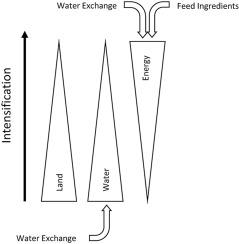Ocean & Coastal Management ( IF 4.6 ) Pub Date : 2021-03-15 , DOI: 10.1016/j.ocecoaman.2021.105595 Robert P. Davis , Claude E. Boyd , D. Allen Davis

|
Aquaculture production is an important part of the global food supply and has equaled or surpassed fisheries production as the main source of aquatic foods. Aquaculture is a resource intensive practice that can use large amounts of land, water, energy, and cause pollution and degradation to the local environment. Intensive production practices have been criticized in the past for causing environmental harm; however recent studies have suggested that resource use may decrease with increasing production intensities at the farm level. Here we used a conceptual farm to access the impact of a few key production parameters on land, water, and energy use. A series of calculations were conducted at various production intensities with modifications made to the type of feed used and water exchange rate. The resulting relationships were then modeled with production intensity. Additionally, the effect of various feedstuffs on embodied resource coefficients was examined through varying protein and carbohydrate feedstuffs. Land and water use were found to have an asymptotic relationship with production intensity, with the most important factor in land use being production intensity and the most important factor in water use being the water exchange rate. Energy use was found to be higher with a diet that has fish meal as a protein source and at higher water exchange rates. The most land intensive diets used for shrimp contained high fish meal with rice as carbohydrate feedstuffs (0.550 ha/tonne). The most water intensive diet was no fish meal with corn as a carbohydrate (1863 m3/tonne), and the most energy intensive diet was high fish meal with corn as a carbohydrate (11.73 GJ/tonne). The results herein suggest that intensifying shrimp aquaculture could save resources based on per tonne of production basis.
中文翻译:

资源共享和资源节约,了解生产强度和养殖方式在对虾养殖中资源利用中的作用
水产养殖产量是全球粮食供应的重要组成部分,已经成为或超过渔业产量,成为水产食品的主要来源。水产养殖是一种资源密集型的活动,会消耗大量的土地,水,能源,并对当地环境造成污染和退化。过去,集约化生产实践曾因对环境造成损害而受到批评。然而,最近的研究表明,随着农场一级生产强度的增加,资源的使用可能会减少。在这里,我们使用概念农场来获取一些关键生产参数对土地,水和能源使用的影响。在各种生产强度下进行了一系列计算,并对所用的饲料类型和水交换速率进行了修改。然后用生产强度对所得关系进行建模。另外,通过改变蛋白质和碳水化合物的饲料,研究了各种饲料对具体资源系数的影响。土地和水的使用与生产强度具有渐近关系,土地使用中最重要的因素是生产强度,而用水中最重要的因素是水交换率。人们发现,以鱼粉为蛋白质源且水交换率较高的饮食,其能量消耗较高。用于虾的土地密集型饮食中,高鱼粉和大米作为碳水化合物饲料(0.550公顷/吨)。最耗水的饮食是没有以玉米为碳水化合物的鱼粉(1863 m 通过改变蛋白质和碳水化合物的饲料,研究了各种饲料对具体资源系数的影响。土地和水的使用与生产强度具有渐近关系,土地使用中最重要的因素是生产强度,而用水中最重要的因素是水交换率。人们发现,以鱼粉为蛋白质源且水交换率较高的饮食,其能量消耗较高。用于虾的土地密集型饮食中,高鱼粉和大米作为碳水化合物饲料(0.550公顷/吨)。最耗水的饮食是没有以玉米为碳水化合物的鱼粉(1863 m 通过改变蛋白质和碳水化合物的饲料,研究了各种饲料对具体资源系数的影响。土地和水资源利用与生产强度之间具有渐近关系,土地利用中最重要的因素是生产强度,而水资源利用中最重要的因素是水交换率。人们发现,以鱼粉为蛋白质源且水交换率较高的饮食,其能量消耗较高。用于虾的土地密集型饮食中,高鱼粉和大米作为碳水化合物饲料(0.550公顷/吨)。最耗水的饮食是没有以玉米为碳水化合物的鱼粉(1863 m 土地和水的使用与生产强度具有渐近关系,土地使用中最重要的因素是生产强度,而用水中最重要的因素是水交换率。人们发现,以鱼粉为蛋白质源且水交换率较高的饮食,其能量消耗较高。用于虾的土地密集型饮食中,高鱼粉和大米作为碳水化合物饲料(0.550公顷/吨)。最耗水的饮食是没有以玉米为碳水化合物的鱼粉(1863 m 发现土地和水的使用与生产强度具有渐近关系,土地使用中最重要的因素是生产强度,而用水中最重要的因素是水交换率。人们发现,以鱼粉为蛋白质源且水交换率较高的饮食,其能量消耗较高。用于虾的土地密集型饮食中,高鱼粉和大米作为碳水化合物饲料(0.550公顷/吨)。最耗水的饮食是没有以玉米为碳水化合物的鱼粉(1863 m 用于虾的土地密集型饮食中,高鱼粉和大米作为碳水化合物饲料(0.550公顷/吨)。最耗水的饮食是没有玉米粉作为碳水化合物的鱼粉(1863 m 用于虾的土地密集型饮食中,高鱼粉和大米作为碳水化合物饲料(0.550公顷/吨)。最耗水的饮食是没有以玉米为碳水化合物的鱼粉(1863 m3 /吨),而最耗能的饮食是玉米粉作为碳水化合物的高鱼粉(11.73 GJ /吨)。本文的结果表明,对虾养殖的集约化可以节省每吨产量的资源。



























 京公网安备 11010802027423号
京公网安备 11010802027423号